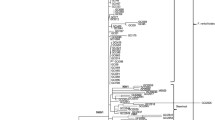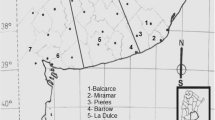Abstract
Gibberella fujikuroi is composed of at least nine mating populations (MPs), corresponding to biological species and assigned letters (from A to I). Each MP possesses a specific toxicological profile and a preferential host. Members of Fusarium verticillioides and F. thapsinum, anamorphs respectively of MPs A (G. moniliformis) and F (G. thapsina), share identical morphological traits, but they have a different preferential hosts (maize and sorghum, respectively) and toxin profiles, beingable the only member of MP A to produce fumonisins and the only member of MP F to produce moniliformin. Isolates from banana fruits were identified morphologically as F. verticillioides. The isolates were analyzed for fumonisin and moniliformin production. While none of the isolates produced fumonisin, all the isolates produced moniliformin. The isolates were crossed with tester strains of MPs A and F, showing ability to produce fertile perithecia only when crossed by MP A tester strains isolated from maize. However, the time required for the formation of fertile perithecia and their size differed significantly from the usual fertile crosses of strains belonging to MP A. Pathogenicity tests using such isolates of F. verticillioides isolated from banana and a set of F. verticillioides isolates isolated from maize were also performed on banana fruits. The data showed that the isolates from banana were more pathogenic. Finally, isolates from banana and maize were compared using AFLP. The results revealed that isolates from banana and maize produced two distinctly different clusters. In conclusion, isolates of F. verticillioides from banana showed specific traits (toxin production, in vitro fertility, pathogenicity and molecular profiles), that were different to those of the same species from maize. This could reflect important differences in the ecology and natural history of the population from banana and should encourage further investigations into the mechanisms of toxin production and pathogenicity within the same MP.
Similar content being viewed by others
References
Bottalico A, Visconti A and Solfrizzo M (1982) Production of moniliformin by Fusarium species in Italy. Phytopathologia Mediterranea 21: 105-106
Desjardins AE, Plattner RD and Nelson PE (1997) Production of fumonisin B1 and moniliformin by Gibberella fujikuroi from rice from various geographic areas. Applied Environmental Microbiology 63: 1838-1842
Hirata T, Kimishima E, Aoki T, Nirenberg HI and O'Donnell K (2001) Morphological and molecular characterization of Fusarium verticillioides from rotten banana imported into Japan. Mycoscience 42: 155-166
Huss MJ and Leslie JF (1996) Isozyme variation among biological species in the Gibberella fujikuroi species complex (Fusarium section Liseola). Applied and Environmental Microbiology 62: 3750-3756
Jiménez M, Huerta T and Mateo R (1997) Mycotoxin production by Fusarium species isolated from bananas. Applied and Environmental Microbiology 63: 364-369
Jiménez M, Logrieco A and Bottalico A (1993) Occurrence and pathogenicity of Fusarium species in banana fruits. Journal of Phytopathology 137: 214-220
Klittich CJR and Leslie JF (1988) Nitrate reduction mutants of Fusarium moniliforme (Gibberella fujikuroi). Genetics 118: 417-423
Klittich CJR, Leslie JF, Nelson PE and Marasas WFO (1997) Fusarium thapsinum (Gibberella thapsina): A new species in section Liseola from sorghum. Mycologia 89: 643-652
Leslie JF (1995) Gibberella fujikuroi: Available populations and variable traits. Canadian Journal of Botany 73: S282-S291
Leslie JF and Klein KK (1996) Female fertility and mating type effects on effective population size and evolution in filamentous fungi. Genetics 144: 557-567
Leslie JF and Marasas WFO (2002) Will the real 'Fusarium moniliforme' please stand up! In: Leslie JF (ed.) Sorghum and Millets Diseases (pp 201–209), Iowa State Press, Ames, Iowa, USA
Leslie JF, Marasas WFO, Shephard GS, Sydenham EW, Stockenström S and Thiel PG (1996) Duckling toxicity and the production of fumonisin and moniliformin by isolates in the A and F mating populations of Gibberella fujikuroi (Fusarium moniliforme). Applied and Environmental Microbiology 62: 1182-1187
Leslie JF, Plattner RD, Desjardins AE and Klittich CJR (1992) Fumonisin B1 production by strains from different mating populations of Gibberella fujikuroi (Fusarium section Liseola). Phytopathology 82: 341-345
Leslie et al. (2001) ?.
Marasas WFO, Miller JD, Riley RT and Visconti A (2001a) Fumonisins-Occurrence, toxicology, metabolism, and risk assessment. In: Summerell BA, Leslie JF, Backhouse D, Bryden WL and Burgess LW (eds) Fusarium: Paul E. Nelson Memorial Symposium (pp 332–359) APS Press, St. Paul, Minnesota USA
Marasas WFO, Rheeder JP, Lamprecht SC, Zeller KA and Leslie JF (2001b) Fusarium andiyazi sp. nov., a new species from sorghum. Mycologia 93: 1203-1210
Marasas, WFO, Thiel PG, Rabie CJ, Nelson PE and Toussoun TA (1986) Moniliformin production in Fusarium section Liseola. Mycologia 78: 242-247
Mirete S, Vásquez C, MulèG, Jurado M and Gonzàlez-Jaén MT (this issue) Differentiation of Fusarium verticillioides from banana fruits by IGS and EF-1? sequence analyses. European Journal of Plant Pathology
Moretti A, Bennett GA, Logrieco A, Bottalico A and Beremand MN (1995) Fertility of Fusarium moniliforme from maize and sorghum related to fumonisin production in Italy. Mycopathologia 131: 25-29
Mulè G, Susca A, Stea G and Moretti A (2004) Specific detection of the toxigenic species Fusarium proliferatum and F. oxysporum from asparagus plants using primers based on calmodulin gene sequences. FEMS Microbiology Letters 230: 235-240
Munkvold G, Stahr HM, Logrieco A, Moretti A and Ritieni A (1998) Occurrence of fusaproliferin and beauvericin in Fusarium-contaminated livestock feed in Iowa. Applied and Environmental Microbiology 64: 3923-3926
Nei M and Li WH (1979) Mathematical model for studying genetic variations in terms of restriction endonucleases. Proceeding National Academic of Science USA 76: 5269-5273
Nelson PE, Toussoun TA and Marasas WFO (1983) Fusarium species: An illustrated Manual for Identification (193 pp). Pennsylvania State University Press, University Park, PA, USA
Nirenberg HI and O'Donnell K (1998) New Fusarium species and combinations within the Gibberella fujikuroi species complex. Mycologia 90: 434-458
O'Donnell K, Cigelnik E and Nirenberg HI (1998) Molecular systematics and phylogeography of the Gibberella fujikuroi species complex. Mycologia 90: 465-493
O'Donnell K, Nirenberg HI, Aoki T and Cigelnik E (2000) A multigene phylogeny of the Gibberella fujikuroi species complex: Detection of additional phylogenetically distinct species. Mycoscience 41: 61-78
Ploetz RC, Zentmayer GA, Nishjima WT, Rohrbach KG and Ohr HD (1994) Compendium of tropical fruit diseases (pp 2–22). APS Press, St. Paul, Minesota, USA
Samuels GJ, Nirenberg HI and Seifert KA (2001) Perithecial species of Fusarium. In: Summerell BA, Leslie JF, Backhouse D, Bryden WL and Burgess LW (eds) Fusarium: Paul E. Nelson Memorial Symposium (pp 1–14) APS Press, St. Paul, Minnesota, USA
Wollenweber HW (1931) Fusarium-monographie. Fungi parasitici et saprophytici. Z. Parasitenk. 3: 397
Zeller KA, Summerell BA, Bullock S and Leslie JF (2003a) Gibberella konza (Fusarium konzum) sp. nov., a new species within the Gibberella fujikuroi species complex from native prairie grasses. Mycologia 95: 943-954
Zeller KA, Wohler MA, Gunn LV, Bullock S, Summerell BA and Leslie JF (2003b) Interfertility and marker segregation in hybrid crosses of Gibberella fujikuroi and Gibberella intermedia. Fungal Genetics Newsletter 50: 144
Author information
Authors and Affiliations
Corresponding author
Rights and permissions
About this article
Cite this article
Moretti, A., Mulè, G., Susca, A. et al. Toxin Profile, Fertility and AFLP Analysis of Fusarium verticillioides from Banana Fruits. European Journal of Plant Pathology 110, 601–609 (2004). https://doi.org/10.1023/B:EJPP.0000032399.83330.d7
Issue Date:
DOI: https://doi.org/10.1023/B:EJPP.0000032399.83330.d7




